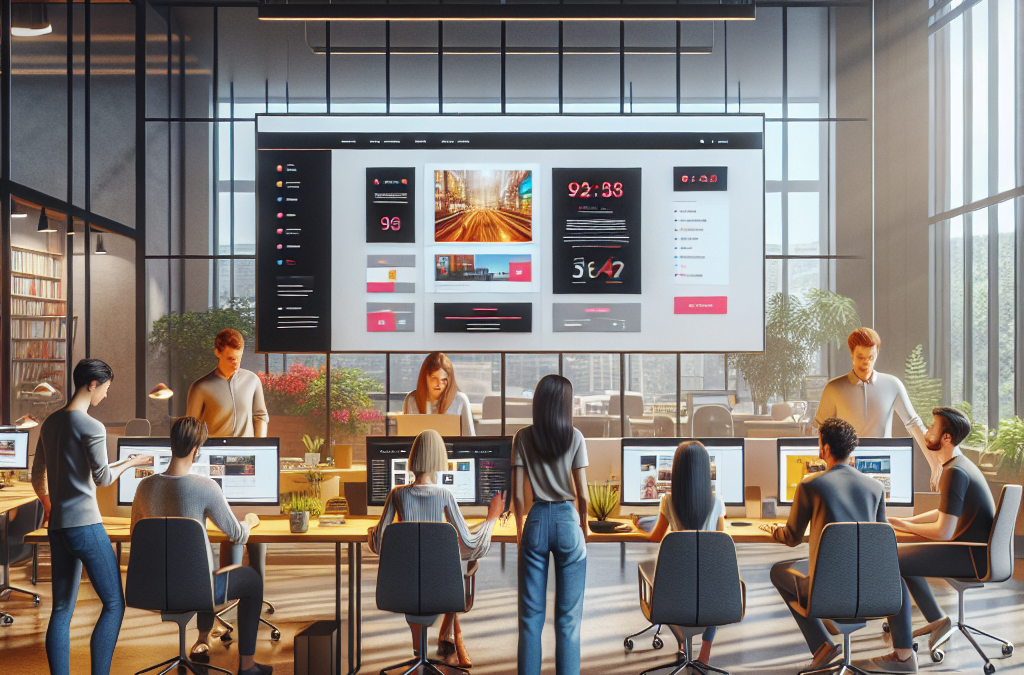
by Guru IS | Aug 3, 2024 | Digital Marketing
In today’s digital age, social media has evolved far beyond simple status updates and photo sharing. Businesses are increasingly recognizing the immense potential of social platforms as powerful tools for growth and engagement. However, while many companies understand the basics of social media, few have fully harnessed the advanced strategies that can drive significant business success.
As we move beyond the basics, it’s essential to focus on strategies that not only increase visibility but also foster authentic connections with your audience. Advanced social media strategies encompass a wide range of activities, from data-driven content creation and influencer partnerships to targeted ad campaigns and real-time engagement metrics. These approaches require a deeper understanding of your audience, meticulous planning, and a willingness to adapt to the ever-changing social landscape.
By leveraging these sophisticated tactics, businesses can unlock new opportunities for growth, improve customer loyalty, and achieve a competitive edge. Whether you’re looking to expand your reach, boost your brand’s reputation, or drive more conversions, diving into advanced social media strategies is a crucial step towards achieving your goals.
Ready to take your social media efforts to the next level? Get a quote and let us help you unlock the full potential of your social platforms.
Identifying Target Audience on Social Media
Understanding and identifying your target audience is a foundational step in any advanced social media strategy. Without clear insights into who your audience is, your efforts can quickly become misdirected, leading to wasted time and resources. Identifying your target audience on social media involves a combination of research, analysis, and continuous refinement.
Start by analyzing your existing customer base. Look at demographics such as age, gender, location, and interests, and use this data to create detailed buyer personas. These personas should represent your ideal customers and guide your content and engagement strategies.
Social media platforms themselves offer valuable tools for audience insights. For example, Facebook’s Audience Insights and Twitter Analytics can provide detailed information about the demographics and behaviors of your followers. Utilize these tools to gather more specific data and adjust your strategies accordingly.
Additionally, consider monitoring social conversations related to your industry. Tools like Hootsuite, Sprout Social, and Brandwatch allow you to track keywords and hashtags to see what topics resonate with your audience. This can help you identify trends and interests that you might not have been aware of.
Finally, don’t forget to engage with your audience directly. Conduct polls, surveys, and Q&A sessions to gather feedback and understand their needs and preferences. This ongoing dialogue can provide critical insights and help you refine your strategies for better alignment with your audience’s expectations.
Creating Engaging and Shareable Content

Once you have a clear understanding of your target audience, the next step is to focus on creating content that not only resonates with them but also encourages engagement and sharing. This is crucial for amplifying your brand’s reach and driving business growth through social media. Engaging and shareable content can significantly enhance your visibility and foster a community around your brand.
Start by ensuring that your content is relevant and valuable to your audience. Content that addresses their pain points, answers their questions, or entertains them is more likely to be shared. Use storytelling techniques to make your content more relatable and compelling. A good story can evoke emotions and create a deeper connection with your audience.
Visual content tends to perform better on social media. Incorporate high-quality images, infographics, and videos to make your posts more attractive. Platforms like Instagram and Pinterest are particularly visual-centric, but even on text-heavy platforms like Twitter and LinkedIn, visual elements can capture attention more effectively.
Interactive content is another powerful tool. Quizzes, polls, and interactive infographics can engage users more deeply and encourage them to share their results or opinions with their network. This not only increases engagement but also helps in spreading your content organically.
Don’t forget the importance of timing and frequency. Posting your content at times when your audience is most active can significantly boost engagement. Tools like Buffer and Hootsuite can help you schedule your posts for optimal times based on your audience’s activity patterns.
Finally, always include a clear call-to-action in your content. Whether it’s asking your audience to share their thoughts in the comments, tag a friend, or visit your website, a clear CTA can drive the desired actions and boost your content’s impact.
Leveraging Influencer Partnerships

In the realm of social media, influencer partnerships have become an invaluable strategy for businesses looking to expand their reach and build credibility. Influencers, who are individuals with a substantial and engaged following, can help amplify your brand message and connect with potential customers in a more authentic and impactful way.
To effectively leverage influencer partnerships, start by identifying influencers whose audience aligns with your target demographic. Look for influencers who share similar values and have a genuine interest in your industry or product. Tools like BuzzSumo and Social Blade can assist you in finding suitable influencers based on their engagement metrics and content relevance.
Once you have a shortlist of potential influencers, engage with them authentically. This means commenting on their posts, sharing their content, and starting a conversation. Building a relationship before proposing a partnership can increase the likelihood of a successful collaboration. When reaching out, be clear about what you hope to achieve and how the partnership could be mutually beneficial.
There are several ways to collaborate with influencers, including sponsored posts, product reviews, giveaways, and takeovers. Sponsored posts involve paying influencers to promote your product or service, while product reviews provide an opportunity for influencers to share their honest opinions. Giveaways can generate buzz and attract new followers, while takeovers—where influencers temporarily control your social media account—can offer fresh and engaging content.
It is essential to track the performance of your influencer partnerships to ensure they are delivering the desired results. Use analytics tools to measure engagement rates, follower growth, and conversions. This data will help you assess the effectiveness of the partnership and make informed decisions for future collaborations.
By strategically leveraging influencer partnerships, you can tap into new audiences, enhance your brand’s credibility, and drive meaningful engagement with your content.
Utilizing Analytics for Continuous Improvement

To unlock the full potential of your social media efforts, it’s crucial to utilize analytics for continuous improvement. Analytics provide invaluable insights into how your content performs, helping you make data-driven decisions to refine your strategy and achieve better results.
Start by setting up analytics tools on your social media platforms. Most major platforms, such as Facebook, Instagram, Twitter, and LinkedIn, offer built-in analytics dashboards. Additionally, third-party tools like Google Analytics, Hootsuite, and Sprout Social can provide more detailed and cross-platform analysis.
Focus on key performance indicators (KPIs) that align with your business goals. Common KPIs include engagement rates, follower growth, click-through rates, and conversion rates. These metrics will help you understand what type of content resonates with your audience and which strategies drive the most engagement and conversions.
Regularly review your analytics to identify trends and patterns. For instance, you might discover that posts published at certain times of the day receive higher engagement or that particular types of content—such as videos or infographics—perform better than others. Use this information to optimize your posting schedule and content mix.
Conduct A/B testing to experiment with different content formats, headlines, and calls-to-action. By comparing the performance of different versions of a post, you can determine which elements are most effective and refine your approach accordingly. A/B testing is a powerful way to continuously improve your content and maximize its impact.
Don’t forget to benchmark your performance against industry standards and competitors. This will help you set realistic goals and identify areas where you can gain a competitive edge. Tools like SocialBakers and Rival IQ can provide valuable benchmarking data.
By consistently utilizing analytics for continuous improvement, you can make informed decisions that enhance your social media strategy, increase engagement, and drive business growth.
Integrating Social Media with Other Marketing Channels

Integrating social media with other marketing channels is a strategic move that can amplify your overall marketing efforts and create a cohesive brand experience for your audience. By ensuring your social media activities are aligned with email marketing, content marketing, SEO, and paid advertising, you can maximize your reach and engagement.
Start by cross-promoting content across different platforms. For instance, share your latest blog posts on social media to drive traffic to your website, or use snippets from your email newsletters as engaging social media posts. This not only provides consistent messaging but also leverages the strengths of each channel to enhance visibility and interaction.
Email marketing and social media can work hand-in-hand to build and nurture your audience. Use social media to encourage followers to sign up for your email list by offering exclusive content or promotions. Conversely, include social media buttons in your emails to make it easy for subscribers to follow and share your content on their social networks.
SEO and social media integration is another powerful combination. Optimize your social media profiles and posts with relevant keywords to improve search engine rankings. Engaging content that gets shared frequently can boost your site’s domain authority and drive organic traffic. Tools like SEMrush and Ahrefs can help you identify effective keywords and track your social media impact on SEO.
Paid advertising on social media and other platforms can also be synchronized for better results. Use data from your social media campaigns to inform your ad targeting strategies on Google Ads or other PPC platforms. Retargeting ads can help you re-engage users who have interacted with your social media content but haven’t yet converted.
Integration also means consistent branding and messaging across all channels. Ensure that your visual and textual content aligns with your brand’s voice and aesthetics. This creates a seamless experience for your audience, regardless of where they encounter your brand.
By integrating social media with other marketing channels, you create a synergistic effect that enhances your overall marketing strategy, driving more significant results and fostering long-term growth. Get a quote at https://guru-is.com/#contact to discover how we can help you achieve absolute web success through innovative web design and integrated marketing strategies.

by Guru IS | Aug 3, 2024 | Website Development
The evolution of web development has brought numerous methodologies and frameworks to the forefront. One such innovation making significant waves is Jamstack. This modern architecture is designed to make the web faster, more secure, and easier to scale. But what exactly is Jamstack and why is it gaining so much traction?
The term Jamstack stands for JavaScript, APIs, and Markup. At its core, the Jamstack architecture decouples the frontend and backend processes, allowing developers to build dynamic web applications with static site generators and frontend frameworks. This separation simplifies development and enhances performance by serving pre-built files directly from a Content Delivery Network (CDN).
Unlike traditional web architectures where backend servers dynamically generate content for each request, Jamstack leverages pre-rendered static files that are instantly available. This approach not only boosts speed but also improves security, as there are fewer server vulnerabilities to exploit.
As businesses look to enhance their online presence, understanding the benefits of Jamstack becomes crucial. By adopting this modern architecture, companies can create visually stunning, user-friendly websites that drive real business success. Dive deeper into our exploration of Jamstack to discover how it can revolutionize your web development strategy.
Ready to transform your web presence? Get a quote at https://guru-is.com/#contact
Benefits of Jamstack Architecture
The rise of Jamstack is not just a trend but a significant shift in how modern web development is approached. The benefits of Jamstack architecture are manifold, making it an attractive option for developers and businesses alike.
Performance is one of the standout advantages. By serving pre-built static files from a Content Delivery Network (CDN), Jamstack websites load faster and provide a seamless user experience. This speed enhancement is crucial in today’s digital age, where users expect instant access to online content.
Security is another key benefit. Traditional web architectures often rely on dynamic servers, which can be susceptible to attacks and vulnerabilities. In contrast, Jamstack minimizes the attack surface by eliminating the need for server-side processing. With no direct interaction with databases or sensitive information, the risk of security breaches is significantly reduced.
Scalability is also greatly improved with Jamstack. Since static files are served directly from a CDN, handling sudden traffic spikes becomes easier and more cost-effective. There’s no need for complex server configurations or resource-intensive operations, making it an ideal solution for growing businesses.
Moreover, Jamstack promotes a better developer experience. The decoupled nature of the architecture allows developers to work with various tools and frameworks, fostering creativity and innovation. This flexibility leads to more efficient workflows and a quicker time-to-market for web projects.
From enhanced performance and security to scalability and improved developer experience, the benefits of Jamstack architecture make it a game-changer in the realm of modern web development.
Improved Performance and Speed

One of the most compelling reasons for the rise of Jamstack in modern web development is its ability to deliver improved performance and speed. In an era where users expect websites to load in a blink, Jamstack architecture stands out by providing lightning-fast performance.
The secret behind this speed lies in the use of pre-built static files. Unlike traditional server-rendered pages that generate content on the fly, Jamstack sites pre-render the entire website and serve these static files directly from a Content Delivery Network (CDN). This approach eliminates the latency associated with server-side processing and database queries, ensuring that web pages load almost instantaneously.
CDNs play a pivotal role in enhancing performance. By distributing static files across multiple geographic locations, CDNs ensure that users access content from the server closest to them. This geographic proximity reduces load times and provides a more consistent user experience, regardless of where the user is located.
Moreover, Jamstack’s architecture allows for the use of caching strategies that further enhance speed. By caching static assets and serving them quickly, Jamstack sites can handle high traffic volumes with ease. This capability is particularly beneficial for e-commerce platforms and high-traffic websites that require reliable performance during peak times.
Finally, Jamstack’s decoupled nature enables developers to optimize individual components of the web application for speed. By leveraging modern JavaScript frameworks and build tools, developers can create highly optimized, fast-loading web pages that meet the demands of today’s users.
In summary, Jamstack’s focus on pre-built static files, CDN distribution, and advanced caching techniques makes it an unparalleled choice for achieving improved performance and speed in web development.
Enhanced Security for Websites

Another significant advantage driving the rise of Jamstack in modern web development is the enhanced security it offers for websites. In a digital landscape fraught with security threats, Jamstack provides a robust framework to safeguard web applications from various vulnerabilities.
The architecture of Jamstack inherently reduces potential attack vectors by eliminating the need for a traditional server or database. Since Jamstack sites are pre-rendered and served as static files, there are no servers or databases to hack into. This reduction in server-side components minimizes the risk of server-related exploits such as SQL injection or data breaches.
Additionally, the use of Content Delivery Networks (CDNs) to distribute static files adds an extra layer of security. CDNs are equipped with advanced security features like DDoS protection, SSL/TLS encryption, and secure token authentication. By leveraging these built-in security measures, Jamstack ensures that content delivery is both fast and secure.
Moreover, decoupling the front-end from the back-end allows developers to focus on securing each component individually. This separation means that even if the front-end is compromised, the back-end remains protected, and vice versa. Developers can implement security best practices, such as Content Security Policy (CSP) and Cross-Origin Resource Sharing (CORS), to further fortify the web application.
Another key aspect of Jamstack’s security is the use of immutable deployments. Once a site is built and deployed, the content is immutable, meaning it cannot be altered or tampered with. This immutability ensures that the deployed version of the site remains consistent and secure, preventing unauthorized changes or code injections.
In conclusion, Jamstack’s architecture not only boosts performance but also significantly enhances the security of websites. By reducing server-side attack vectors, leveraging CDN security features, and promoting immutability, Jamstack provides a secure foundation for modern web development.
Scalability and Flexibility

One of the standout benefits of Jamstack in modern web development is its unparalleled scalability and flexibility. As businesses grow and their web traffic increases, having a website architecture that can seamlessly scale is crucial. Jamstack’s architecture is uniquely designed to handle such demands efficiently.
Since Jamstack sites are served as static files via Content Delivery Networks (CDNs), they can easily manage high levels of traffic. CDNs distribute content across multiple servers globally, ensuring that users access the site from the nearest server. This not only accelerates load times but also balances the load efficiently, making it easier to handle traffic spikes without compromising performance.
Furthermore, the decoupled nature of Jamstack allows for greater flexibility. Developers can choose the best tools and technologies for each part of the stack without being tied to a specific platform or framework. This modularity means that components can be updated, replaced, or scaled independently, providing a level of adaptability that is hard to achieve with traditional monolithic architectures.
Another advantage is the ease of deployment and updates. With Jamstack, you can deploy changes rapidly without risking downtime. The build process generates static files that can be deployed quickly to CDNs, ensuring that updates are live almost instantly. This rapid deployment capability is particularly beneficial for businesses that require frequent updates or run time-sensitive promotions.
In addition, the use of APIs to handle dynamic functionalities adds to Jamstack’s flexibility. By relying on third-party APIs for services like authentication, payment processing, and content management, developers can integrate advanced features without the need for a complex back-end. This API-first approach allows for easy integration and scaling of services as business needs evolve.
Overall, Jamstack’s combination of static file serving via CDNs, modular architecture, rapid deployment, and API-first approach makes it an ideal choice for businesses looking to build scalable and flexible web applications. These features ensure that your web platform can grow and adapt in line with your evolving business requirements.
Future of Jamstack in Web Development

As we look ahead, the future of Jamstack in web development promises to be exciting and transformative. The methodology’s emphasis on performance, security, and developer experience aligns perfectly with the evolving needs of modern web applications. With its growing popularity, we can expect to see even more advancements and widespread adoption of Jamstack in the coming years.
One of the primary drivers behind Jamstack’s future growth is the continuous improvement in static site generation tools and frameworks. Innovations from companies like Netlify, Vercel, and others are making it easier than ever to build, deploy, and scale Jamstack applications. These tools are becoming more sophisticated, offering seamless integrations with various frontend frameworks and backend services, thus streamlining the development process.
Additionally, the rise of headless CMS solutions is set to further propel Jamstack forward. Headless CMSs decouple content management from the presentation layer, allowing developers to use their preferred tools and frameworks to build the frontend. This flexibility is a natural fit for Jamstack, enabling more dynamic and engaging web experiences without sacrificing performance or security.
Moreover, the trend towards microservices and serverless architectures complements Jamstack’s principles. By leveraging serverless functions and microservices, developers can add complex functionalities to their applications without managing traditional server infrastructure. This not only reduces operational overhead but also enhances scalability and resilience.
In the realm of e-commerce, Jamstack is poised to make significant inroads. The need for fast, secure, and scalable online stores aligns perfectly with what Jamstack offers. By integrating with headless e-commerce platforms, businesses can deliver lightning-fast shopping experiences that are highly customizable and easy to maintain.
As the demand for highly performant and secure web applications continues to grow, Jamstack is well-positioned to become a mainstream approach in web development. Its ability to deliver a superior user experience while simplifying the development process makes it an attractive choice for developers and businesses alike.
If you’re ready to revolutionize your web presence with Jamstack, get a quote at https://guru-is.com/#contact and let Guru Internet Services help you achieve absolute web success!

by Guru IS | Jul 23, 2024 | Digital Marketing
In today’s digital landscape, internet marketing techniques are essential for any business aiming to thrive. With the rapid evolution of technology, traditional marketing methods have taken a backseat, giving way to innovative online strategies that promise greater reach and engagement. The digital arena offers a plethora of tools and platforms to connect with your target audience, making it vital to understand the various facets of internet marketing.
Internet marketing, also known as online marketing or digital marketing, encompasses a wide range of strategies and tactics. These include search engine optimization (SEO), content marketing, social media marketing, email marketing, and more. Each technique plays a crucial role in driving traffic, generating leads, and ultimately, boosting sales.
Whether you are a startup or an established business, staying ahead of digital marketing trends is crucial for your success. By implementing effective internet marketing techniques—such as creating visually stunning websites and leveraging social media platforms—you can make a significant impact. Understanding these trends and techniques not only keeps you competitive but also enables you to connect with your audience in meaningful and lasting ways..
Ready to elevate your business with cutting-edge internet marketing strategies? Get a quote at https://guru-is.com/#contact and let us help you achieve absolute web success!
Importance of Search Engine Optimization

Search Engine Optimization, or SEO, is a fundamental component of any robust internet marketing strategy. SEO involves optimizing your website and its content to rank higher in search engine results pages (SERPs), thereby increasing your site’s visibility to potential customers. When done correctly, SEO can drive organic traffic to your website, reduce acquisition costs, and improve conversion rates.
The importance of SEO cannot be overstated. With millions of websites competing for attention, appearing on the first page of search results can significantly enhance your chances of attracting visitors. According to studies, the first page of Google captures 71% of search traffic clicks, underscoring the necessity of achieving high rankings.
Effective SEO is a blend of on-page and off-page optimization techniques. On-page SEO focuses on optimizing individual web pages, including keyword usage, meta descriptions, and internal linking. Off-page SEO, on the other hand, involves external factors such as backlinks and social signals. Both aspects are crucial for improving your site’s authority and relevance in the eyes of search engines.
Moreover, SEO is not a one-time effort but an ongoing process. Search engine algorithms are continually evolving, and staying updated with the latest trends and best practices is essential for maintaining and improving your rankings. By investing in SEO, you can ensure that your website remains competitive and continues to attract organic traffic over the long term.
Effective Content Marketing Strategies
Content marketing is a crucial element in the arsenal of internet marketing techniques. It involves creating and distributing valuable, relevant, and consistent content to attract and engage a clearly defined audience. Effective content marketing not only drives traffic but also builds trust and authority, ultimately leading to increased conversions and customer loyalty.
One of the most effective content marketing strategies is understanding your audience. By developing buyer personas, you can tailor your content to address the specific needs, challenges, and preferences of your target market. This personalized approach makes your content more relatable and engaging.
Another essential strategy is maintaining a content calendar. Consistency is key in content marketing, and a well-planned calendar ensures that you are regularly publishing high-quality content. This not only keeps your audience engaged but also signals to search engines that your site is active and relevant.
Leveraging different content formats can also enhance your content marketing efforts. From blog posts and articles to videos, infographics, and podcasts, diversifying your content types can cater to different audience preferences and increase your reach. Additionally, incorporating SEO best practices into your content, such as keyword optimization and internal linking, can further boost your visibility in search engine results.
Lastly, promoting your content through various channels is vital for maximizing its impact. Social media, email marketing, and influencer partnerships can amplify your content’s reach and drive more traffic to your website. By integrating these strategies, you can create a cohesive and effective content marketing plan that supports your overall business objectives.
Leveraging Social Media Platforms

In the realm of internet marketing techniques, leveraging social media platforms is indispensable. Social media not only provides a space to connect with your audience but also offers various tools and analytics to optimize your marketing efforts. To harness the full potential of social media, it’s essential to develop a comprehensive strategy tailored to each platform’s unique features and user demographics.
First, identify which social media platforms are most popular among your target audience. Whether it’s Facebook, Instagram, Twitter, LinkedIn, or TikTok, understanding where your audience spends their time will help you focus your efforts more effectively. Each platform has its own strengths: Instagram is great for visual storytelling, LinkedIn excels in professional networking, while Twitter is ideal for real-time updates and conversations.
Creating engaging and shareable content is another cornerstone of a successful social media strategy. This can include a mix of posts, such as promotional content, behind-the-scenes looks, user-generated content, and interactive polls or quizzes. The goal is to foster a sense of community and encourage user interaction, which can lead to increased brand loyalty and organic reach.
Utilizing social media analytics tools can help you track the performance of your posts and campaigns. Metrics such as engagement rates, click-through rates, and follower growth can provide valuable insights into what is working and what needs adjustment. By regularly analyzing this data, you can make informed decisions and continually refine your strategy.
Finally, don’t underestimate the power of social media advertising. Paid campaigns can significantly boost your visibility and reach a broader audience. With advanced targeting options, you can ensure that your ads are seen by users who are most likely to be interested in your products or services. Combining organic and paid strategies can create a robust social media presence that drives real business results.
Email Marketing Best Practices

Email marketing remains one of the most effective internet marketing techniques for reaching and engaging your audience. However, to maximize its potential, it’s crucial to follow some best practices. A well-executed email marketing campaign can lead to higher open rates, click-through rates, and ultimately, conversions.
First and foremost, building a quality email list is essential. Rather than purchasing email lists, focus on organically growing your list by offering valuable content or incentives in exchange for email sign-ups. This ensures that your subscribers are genuinely interested in your brand, leading to higher engagement.
Once you have a robust list, segmenting your audience can make a significant difference. By categorizing subscribers based on their behaviors, preferences, or demographics, you can tailor your messages to be more relevant to each group. Personalized emails tend to perform better as they address the specific needs and interests of the recipient.
The design and content of your emails also play a pivotal role in their success. Ensure your emails are visually appealing, mobile-friendly, and easy to read. Include compelling subject lines to capture attention and concise, engaging content to maintain it. Incorporate clear calls-to-action (CTAs) that guide recipients on the next steps you want them to take.
Regularly testing and analyzing your email campaigns is another best practice. A/B testing different elements such as subject lines, email copy, and CTAs can provide insights into what resonates best with your audience. Use this data to continually refine your approach and improve your results.
Lastly, maintain compliance with email marketing regulations such as the CAN-SPAM Act or GDPR. Provide easy opt-out options and respect the privacy of your subscribers. Building trust through transparency and respect can enhance your brand’s reputation and foster long-term relationships with your audience.
Utilizing Pay-Per-Click Advertising

Pay-Per-Click (PPC) advertising is a powerful tool within the realm of internet marketing techniques that can drive immediate traffic and conversions. By utilizing platforms such as Google Ads or Bing Ads, businesses can display ads to users actively searching for specific keywords related to their products or services.
One of the main advantages of PPC advertising is its ability to provide instant visibility. Unlike organic search engine optimization (SEO), which can take time to yield results, PPC campaigns can generate traffic as soon as they are launched. This makes it an ideal method for promotions, new product launches, or driving traffic to time-sensitive offers.
To maximize the effectiveness of your PPC campaigns, thorough keyword research is essential. Identify high-intent keywords that are relevant to your business and have a good balance of search volume and competition. Using tools like Google Keyword Planner can help you uncover valuable keyword opportunities.
Crafting compelling ad copy is another critical element of successful PPC advertising. Your ads should be clear, concise, and include a strong call-to-action (CTA). Highlight your unique selling propositions (USPs) to differentiate your ads from competitors and entice users to click.
It’s also important to continuously monitor and optimize your PPC campaigns. Track key performance indicators (KPIs) such as click-through rates (CTR), conversion rates, and cost-per-click (CPC) to assess the effectiveness of your ads. Regularly adjusting bids, testing different ad variations, and refining your targeting can lead to better performance and a higher return on investment (ROI).
Lastly, leveraging remarketing strategies can enhance your PPC efforts. By targeting users who have previously visited your website but did not convert, you can re-engage potential customers and encourage them to complete their purchase. Remarketing campaigns often have higher conversion rates as they target users already familiar with your brand.
Ready to take your internet marketing to the next level? Get a quote at https://guru-is.com/#contact and let us help you create impactful PPC campaigns that drive results!

by Guru IS | Jul 21, 2024 | Website Design
In today’s digital age, having a visually appealing and user-friendly website is crucial for any business looking to thrive. **Local web design** services offer a unique advantage by providing personalized and tailored solutions that align with local market trends and customer preferences. Choosing a web design service near you ensures that you can collaborate closely with the designers, making it easier to communicate your vision and requirements.
One of the primary benefits of opting for web design near me is the ability to support local businesses while also ensuring that your website is optimized for local SEO, helping you attract more customers from your area. By working with a local web design company, you can leverage their knowledge of the local market to create a website that truly resonates with your target audience.
Moreover, local web design services often come with the added benefit of face-to-face meetings and on-site consultations, fostering a stronger working relationship and more effective communication. This level of personal engagement can lead to a more seamless design process and a final product that perfectly aligns with your business goals.
Are you ready to transform your online presence with a stunning, locally crafted website? Get a quote at https://guru-is.com/#contact and take the first step towards absolute web success for your business!
Benefits of Hiring Local Web Designers

Hiring local web designers can provide numerous benefits that can significantly impact your business’s online success. One of the most compelling advantages is the deep understanding local designers have of the community and market trends. This knowledge allows them to create a website that speaks directly to your target audience, ensuring a more personalized and relevant user experience.
Another key benefit is the ease of communication. With local web designers, you can schedule face-to-face meetings, which can lead to more effective collaboration and quicker resolution of any issues that may arise during the design process. This direct interaction fosters a stronger working relationship and ensures that your vision is clearly understood and executed.
Additionally, local web designers are often more invested in the success of local businesses. They are likely to go the extra mile to deliver a high-quality product, as their reputation within the community is at stake. This sense of accountability can result in a more dedicated and responsive service.
Local web designers also bring a unique advantage in terms of local SEO. They are familiar with the keywords and search trends specific to your area, which can help optimize your website to attract more local traffic. This localized approach to SEO can drive more qualified leads to your business, ultimately increasing your chances of converting visitors into customers.
By hiring local web designers, you not only get a website that is tailored to your specific needs but also contribute to the local economy. Supporting local talent fosters community growth and can lead to long-term partnerships that benefit both your business and the local industry.
How to Find Top Web Design Near Me

Finding top web design services near you can be a game-changer for your business’s online presence. To start, leverage online search engines by using specific keywords like “web design near me”. This will yield a list of local web design agencies and freelancers. Don’t just rely on the first few results; dig deeper to explore more options.
Next, check online reviews and ratings on platforms such as Google My Business, Yelp, and social media. Pay attention to both the overall rating and individual reviews to get a sense of the designer’s strengths and weaknesses. Look for recurring themes in the feedback—both positive and negative—to make a more informed decision.
Networking can also be a valuable strategy. Ask for recommendations from other business owners within your local community or industry. Personal testimonials can provide insights that you might not find online, helping you identify trustworthy and competent designers.
Once you have a shortlist, visit the websites of these potential web designers. Analyze their portfolios to assess their design style, functionality, and user experience. A well-rounded portfolio should demonstrate versatility and an ability to cater to different industries. Don’t hesitate to reach out to these designers to discuss your project and gauge their responsiveness and enthusiasm.
Additionally, consider attending local business events, meetups, or web design conferences. These gatherings offer opportunities to meet designers in person, ask questions, and even see live demonstrations of their work. Engaging with designers face-to-face can provide a clearer picture of their capabilities and professionalism.
Finally, verify the credentials and experience of the web designers. Look for certifications, awards, or memberships in professional organizations. This can be an indicator of their commitment to staying updated with industry trends and best practices. By following these steps, you can find top web design services near you that align with your business needs and goals.
Key Features of Stunning Websites

Stunning websites are the cornerstone of any successful online presence. To create a website that not only attracts visitors but also keeps them engaged, it’s essential to incorporate certain key features. Here are some must-haves for a visually appealing and highly functional website:
Responsive Design: A responsive design ensures your website looks and functions well on a variety of devices, including desktops, tablets, and smartphones. With the growing number of mobile users, this feature is indispensable for providing a seamless user experience.
Fast Loading Time: Speed is crucial. Websites that load quickly are favored by both users and search engines. Optimize images, leverage browser caching, and use content delivery networks (CDNs) to enhance your site’s performance.
Intuitive Navigation: An easy-to-navigate website helps users find the information they’re looking for without frustration. Utilize a clean, organized menu structure and clear calls to action to guide visitors through your site.
High-Quality Content: Content is king. Ensure that your website offers valuable, relevant, and engaging content. This includes well-written text, professional images, and informative videos. High-quality content not only engages visitors but also boosts your site’s SEO.
SEO Optimization: A stunning website is also optimized for search engines. Use proper meta tags, alt texts for images, and keyword-rich content to improve your site’s visibility on search engine results pages (SERPs).
Security Features: Protecting user data should be a top priority. Implement SSL certificates, secure payment gateways, and regular security updates to build trust and ensure a safe browsing experience.
Social Media Integration: Connect your website with your social media profiles to increase engagement and reach. Social media buttons and sharing options make it easy for visitors to share your content, driving more traffic to your site.
Incorporating these key features will not only make your website visually stunning but also ensure it is functional, user-friendly, and optimized for success. By focusing on these elements, you can create a website that truly stands out and drives real business results.
Questions to Ask Potential Web Designers

Choosing the right web designer is crucial to the success of your website. To ensure you hire the best professional for your project, it’s important to ask the right questions. Here are some essential queries to consider:
Can You Provide Examples of Past Work? Reviewing a designer’s portfolio gives you insight into their style, expertise, and the types of projects they have handled. Look for diversity in their work and ensure their design approach aligns with your vision.
What Is Your Design Process? Understanding how a designer approaches a project can reveal their level of organization and how they handle various stages of the design process. Ask about their methods for gathering requirements, creating wireframes, and managing revisions.
How Do You Handle Revisions and Feedback? Clear communication and the ability to incorporate feedback are vital for a successful collaboration. Inquire about their revision policy and how they manage feedback to ensure your expectations are met.
What Are Your SEO Practices? A well-designed website should also be optimized for search engines. Ask about their experience with SEO and the strategies they use to ensure your site ranks well on search engine results pages (SERPs).
Can You Provide References? Speaking with past clients can give you a better understanding of the designer’s reliability, work ethic, and ability to meet deadlines. References can provide valuable firsthand insights into what it’s like to work with the designer.
What Are Your Rates and Payment Terms? Understanding the financial aspect is essential. Ask about their pricing structure, what is included in the cost, and their payment terms. This helps avoid any surprises and ensures the project stays within budget.
Do You Offer Post-Launch Support? Websites require ongoing maintenance and updates. Clarify if the designer offers post-launch support and what services are included, such as bug fixes, updates, and additional training.
Asking these questions will help you gauge the competency, reliability, and suitability of potential web designers. By doing your due diligence, you can make an informed decision and choose a professional who will deliver a stunning, functional website tailored to your business needs.
Conclusion and Next Steps
Finding the right web design near me can significantly impact your business’s online presence and success. By understanding the importance of local expertise, evaluating portfolios, and asking the right questions, you can make an informed decision and select a designer who aligns with your vision and goals.
Once you’ve narrowed down your options, it’s time to take the next steps. Schedule consultations with your top choices to discuss your project in detail. Use this opportunity to gauge their communication skills, enthusiasm, and willingness to collaborate. Remember, a successful partnership goes beyond technical skills; it also involves mutual trust and understanding.
As you move forward, keep a few key considerations in mind:
- Set Clear Expectations: Clearly communicate your goals, timelines, and budget to ensure everyone is on the same page.
- Stay Involved: Regularly check in on the progress and provide timely feedback to keep the project on track.
- Plan for the Future: Discuss post-launch support and maintenance to ensure your website remains updated and functional.
In conclusion, finding a top-notch web designer near you is a strategic investment in your business’s future. By following the steps outlined in this article, you can confidently select a designer who will create a stunning, user-friendly website that drives real business success.
Ready to transform your online presence? Get a quote at https://guru-is.com/#contact and take the first step towards absolute web success with Guru Internet Services!

by Guru IS | Jul 19, 2024 | Website Design
Los Angeles is a vibrant city known for its innovation and creativity, and this extends into the realm of web design. The city is home to numerous businesses and startups, all vying for attention in the digital space. As a result, having a visually stunning and user-friendly website is crucial for standing out. In this ever-evolving industry, staying updated with the latest web design trends is essential for creating websites that not only look good but also drive real business success. At Guru Internet Services, we specialize in crafting websites that embody the spirit of Los Angeles—innovative, dynamic, and results-driven.
From bold typography to immersive multimedia experiences, the web design trends in Los Angeles are as diverse as the city itself. These trends are influenced by the latest technological advancements and the unique cultural landscape of the region. Whether you’re a small business owner or part of a large corporation, understanding these trends can help you create a website that resonates with your target audience.
Don’t get left behind in the fast-paced world of web design. Get a quote today and let us help you revolutionize your web presence!
Importance of User-Friendly Website Navigation

One of the most critical aspects of web design is ensuring that your website offers user-friendly navigation. In the bustling digital marketplace of Los Angeles, users expect to find information quickly and efficiently. If your website’s navigation is confusing or cluttered, visitors are likely to leave in frustration, leading to a higher bounce rate and lost opportunities.
Effective navigation can significantly enhance the user experience by making it easy for visitors to find what they’re looking for. This includes logical menu structures, intuitive icons, and clear, concise labels. A well-thought-out navigation system not only improves usability but also helps in guiding users through your site in a way that aligns with your business goals.
Moreover, search engines like Google place a high value on user-friendly navigation when ranking websites. A site that is easy to navigate is likely to have better SEO performance, resulting in higher visibility in search engine results pages (SERPs). This is particularly important for businesses in competitive markets like Los Angeles, where appearing on the first page of search results can make a significant difference in attracting potential customers.
Incorporating user-friendly navigation into your web design ensures that your visitors have a seamless and enjoyable experience, which can lead to higher engagement, increased conversions, and ultimately, greater business success.
Incorporating Local Culture into Design

Incorporating local culture into your web design can set your website apart and create a deeper connection with your audience. In a diverse and vibrant city like Los Angeles, reflecting the local culture can make your site more relatable and engaging for visitors.
One way to achieve this is by using visual elements that resonate with the local community. This can include imagery of iconic landmarks, local art, and color schemes that reflect the city’s unique vibe. For example, incorporating shades of blue and gold can evoke the sunny, coastal essence of Los Angeles.
Another important aspect is content localization. Tailoring your website’s language, tone, and messaging to reflect the local dialect and cultural nuances can make your site feel more personal and approachable. Highlighting local events, stories, and testimonials can also strengthen your connection with the local audience.
Additionally, consider integrating elements of the local culture into your site’s functionality. For instance, featuring local business partnerships, promoting community events, or even offering localized customer support can enhance the user experience and foster a sense of community.
By thoughtfully incorporating local culture into your web design, you not only create a more appealing and relevant website but also build trust and loyalty among your local audience. In a competitive market like Los Angeles, this cultural connection can be a powerful differentiator that drives engagement and business success.
Utilizing High-Quality Visuals and Media
In today’s digital landscape, high-quality visuals and media are essential components of a stunning web design. Particularly in a visually-driven market like Los Angeles, where aesthetics are highly valued, incorporating exceptional visuals can significantly enhance user engagement and satisfaction.
First, invest in professional photography and high-resolution images. These visuals can capture the essence of your brand and convey a sense of professionalism and credibility. Avoid using generic stock photos that lack authenticity; instead, opt for custom images that reflect your unique brand identity and resonate with your target audience.
Next, consider the strategic use of videos. Videos are a powerful medium for storytelling and can effectively showcase your products, services, or company culture. Incorporate videos that are well-produced and relevant to your content. This not only keeps visitors engaged longer but also helps in conveying complex information in an easily digestible format.
Moreover, ensure that your media elements are optimized for web performance. Large, unoptimized files can slow down your site, leading to a poor user experience and higher bounce rates. Use appropriate formats and compression techniques to maintain quality while ensuring fast load times. Tools like lazy loading can also help by loading media only when it comes into the user’s viewport.
Lastly, don’t overlook the importance of consistent branding across all visual elements. Ensure that your color schemes, typography, and graphic styles align with your brand guidelines. This creates a cohesive and professional appearance, enhancing brand recognition and trust.
By utilizing high-quality visuals and media thoughtfully, you can create an engaging, visually appealing website that captures the attention of your audience and strengthens your brand presence in the competitive Los Angeles market.
Responsive Design for Mobile Users

In an era where mobile internet usage has surpassed desktop, ensuring your website is responsive is no longer optional—it’s imperative. A responsive design adapts seamlessly to various screen sizes and devices, providing an optimal viewing experience for every user, whether they’re on a smartphone, tablet, or desktop computer.
First, prioritize mobile-first design. This approach involves designing for the smallest screen size first and then scaling up. By focusing on the mobile experience initially, you ensure that essential elements and functionalities are accessible and user-friendly on smaller devices. This approach helps in creating a cleaner, more efficient design that enhances usability across all platforms.
Next, utilize fluid grids and flexible images. Fluid grids use relative units like percentages rather than fixed units like pixels, allowing your layout to resize smoothly across different screen sizes. Similarly, flexible images adapt to the size of their containing element, preventing display issues and improving load times.
Moreover, pay attention to touch-friendly navigation. Mobile users interact with websites through touch, so buttons, links, and navigational elements should be large enough to tap easily. Implementing a sticky navigation bar can also enhance the user experience by providing easy access to key sections of your website without the need to scroll extensively.
Additionally, consider performance optimization for mobile devices. Mobile users often experience slower internet connections, so optimizing your website for speed is crucial. Techniques such as minifying CSS and JavaScript, leveraging browser caching, and using Content Delivery Networks (CDNs) can significantly improve load times.
Lastly, always test your website on multiple devices and browsers. Tools like Google’s Mobile-Friendly Test can help identify any issues and ensure that your site provides a consistent and high-quality experience for all users, regardless of the device they use.
By implementing responsive design principles, you can cater to the growing number of mobile users and provide a seamless, engaging experience that keeps visitors coming back to your site.
Optimizing Websites for Search Engines

To achieve absolute web success in Los Angeles, it’s essential to optimize your website for search engines. Search Engine Optimization (SEO) is a critical factor in driving organic traffic and improving your website’s visibility on search engine results pages (SERPs). By implementing effective SEO strategies, you ensure that your website reaches a broader audience and attracts potential customers.
Start by conducting thorough keyword research. Identify the terms and phrases your target audience is using to search for products or services related to your business. Tools like Google Keyword Planner and SEMrush can help you discover high-ranking keywords and understand their search volume and competition. Incorporating these keywords naturally into your content, meta descriptions, and headers can significantly enhance your site’s visibility.
Next, focus on creating high-quality, engaging content. Search engines prioritize websites that offer valuable and relevant information to users. Regularly updating your site with fresh content, such as blog posts, articles, and videos, not only boosts your SEO but also keeps visitors engaged and encourages them to spend more time on your site.
Technical SEO is equally important. Ensure that your website has a clean, organized code structure and uses proper HTML tags. Optimize your site’s speed by compressing images, minifying CSS and JavaScript files, and leveraging browser caching. A fast-loading website not only improves user experience but also ranks higher on search engines.
Additionally, build a strong backlink profile. Acquiring links from reputable and relevant websites signals to search engines that your site is trustworthy and authoritative. Engage in guest blogging, create shareable content, and participate in industry forums to earn high-quality backlinks.
Lastly, don’t forget about local SEO. For businesses in Los Angeles, optimizing for local search is crucial. Ensure your business information is consistent across all online directories, claim your Google My Business listing, and encourage satisfied customers to leave positive reviews. Local SEO helps you attract nearby customers who are searching for services or products in your area.
By implementing these SEO strategies, you can significantly enhance your website’s search engine ranking and drive more organic traffic. Ready to elevate your online presence? Get a quote at https://guru-is.com/#contact and let Guru Internet Services help you achieve absolute web success!


























